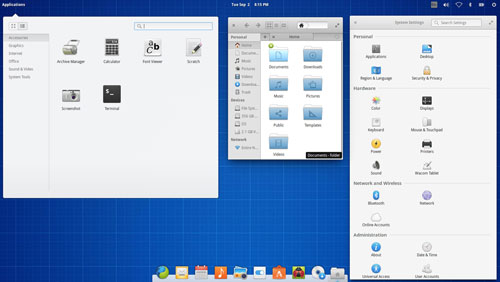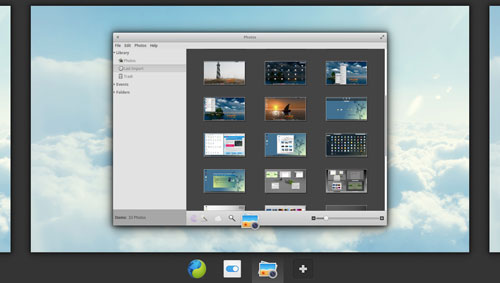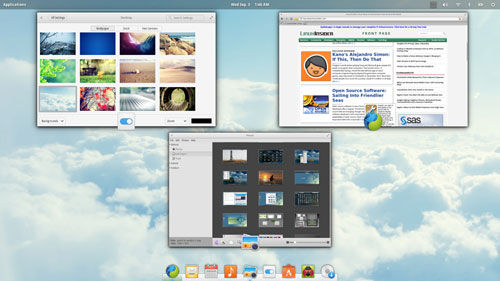
![]()
Elementary OS is a new style Linux distro that wraps its own sophisticated desktop design around a solid Ubuntu core.This distro first appeared in 2011. Its developers released the second major version, Elementary OS Luna, last year. The latest weeks-old beta release of what will be the third major version, called “Freya,” shows that Elementary OS continues to offer Linux users a dependable alternative to popular desktop options.
Some confusion may exist over the name of this next generation Elementary release. It originally was dubbed “Isis.” Developers quickly reissued the beta release under the name “Freya” in response to the mounting international crisis involving the terrorist group known as “ISIS” or “ISIL,” among other names.
I was impressed with the performance of Elementary OS Luna when I first tried it. However, I did not review it then. I wanted to be sure it would not be a disappearing distro. I was concerned about its release cycle.
The Freya beta, however, shows the dedication and proven track record of the developers. Do not let “Elementary” suggest a lightweight or simplified offering in terms of its performance.
Elementary OS is anything but rudimentary. However, to get better usability you will have to install your everyday computing tools from the community’s software center. This software limitation is not just for the Freya beta release. It exists in the Luna version as well.
You can download the Freya beta here.
Beyond Elementary
Elementary OS has its own desktop interface. The design is very deliberate and extremely functional. It is something of a hybrid, though, as it is inspired by Apple’s OS X but based on Debian Ubuntu 14.04 LTS and features Linux kernel 3.13.
The default desktop is Pantheon. It is written using Vala and the GTK3 toolkit.
This desktop bears some similarity to the GNOME 3 Shell and OS X. It has some of the visual finesse of OS X. Its Ubuntu underpinnings are anchored under the hood. It has not even a trace of Unity desktop functionality.
Distinctive Distro
Elementary OS has much more than a unique design to its credit. It is neither a clone of the OS X desktop nor a mimic of a purely GNOME environment. It just looks a little like both of them. Its look and feel remains, well, Elementary.
The traditional Linux panel — sort of — resides at the top of the screen, but it is not really traditional. Like the earlier versions, Freya displays the basic system icons along the right end of the almost-there panel. These include the Language emblem, Internet connection status, Bluetooth and Battery status markers, as well as the Power Off icon to access the dropdown menu.
The date and time are visible in the center of the panel space. An unconventional Applications menu button rests at the left end. A Mac-like configurable docking bar sits in the center bottom of the screen.
Not Your Standard Apps
The developers of Elementary OS deserve a good amount of credit. They have developed a very usable desktop design early on and continue to improve its functionality.
Part of the reason that the Pantheon desktop works so well is that it does not merely recycle existing Linux system tools to make them fit Freya. Rather, the developers created applications built specifically for Elementary OS.
For example, Dexter is an address book. Postler is an email client. Nautilus Elementary is a simple file manager.
At first blush, these in-house tools struck me as too simple to be very useful, but the more I used them, the more I liked how they worked. Yes, their design is simple, but their features let me get my work done with little or no discomfort. I barely had the desire to supplement them with more familiar standardized apps from the Debian software ecosystem.
Standard Works Too
Elementary OS is not like other innovative Linux distros that ventured down a parallel distro road. It runs its own home-grown applications.
If an application runs on Ubuntu, it will run on Elementary OS. In fact, I found that if it runs on Linux Mint, it will run on Elementary OS as well.
That makes Elementary OS a great alternative distro. I tested Elementary OS 2013 Luna on a laptop and Elementary OS Freya beta on a desktop. The user experience — and this is not often the case with early-stage beta versions — was very pleasing and similar with both.
The Software Center is well stuffed with mainstream and specialty Linux applications, but I was a bit disappointed that Elementary OS does not come with other software management systems preinstalled, such as the Synaptic Package Manager and the gDebi Installer.
Freya Freshness
New features in Freya include improvements to the Slingshot Search tool and an updated theme, as well as a new GTK+ and icon theme for GNOME.

One new feature is the ability to search in the Files application with a Ctrl+F shortcut. Another tweak is improved animations.
A big plus to Pantheon is the addition of Online Accounts. This makes it easy to connect with apps to mail, contacts and calendars. It is more convenient than using the Web browser to reach your FastMail, Yahoo, Microsoft, Facebook and Google accounts.
Workspace Washout
For me, one of the most critical functionality points in any Linux distro is how it handles virtual desktops. Distros that let me place a Workplace Switcher app on the panel for near-instant point and click “channel changing” always win high praise from me.
Freya does not do this. The Elementary OS distro uses a GNOME 3-like approach. In this distro, access to virtual workplaces is handled through enabled hot spots. In System Settings, you can enable/disable hot spots in the four screen corners. Several display options are available for each hot spot. This method resembles the hot corner feature in Linux Mint, minus the panel switcher that Linux Mint also provides.
You activate the hot spot activity by moving the mouse pointer into the corner. In the case of using virtual desktops, the hot spot shrinks the desktop view to expose a bottom panel to display the virtual switcher. This method of switching among virtual desktops in Elementary OS resembles an Android process with mouse clicking replacing finger swiping.

In the GNOME 3 desktop, you have to slide open a panel from the right screen edge and drag around thumbnail views. Similarly, in Ubuntu’s Unity desktop, you click the Switcher icon to open a thumbnail view in a pop-up window to click the desired workspace. Both approaches are huge annoyances to me.
Appearance Matters
One of the coolest things in the Freya beta is improvements to the theme design of the top panel. Is transparency changes based on the color of the background wallpaper.
This is a similar eye candy effect to what Unity does, but Freya’s developers improved on this concept. The panel detects when a solid bar is more visible or when a transparent bar displays a better look. The system also adjusts the text color to make it more legible.
Another cool view is how the title bar merges with the toolbars. This not only creates a more pleasant appearance, but also adds a touch of class and efficiency.
Perhaps one of the only things lightweight or cheap about what the developers did in this distro was to make the Midori Web browser the only preinstalled option and to ignore any word processors and text editors.
Of course, it does not take much to add your preferred apps manually — but why not have a mechanism for setting up your choice of default applications for basic computing?
Bottom Line
The 2013, or Luna, version of Elementary OS is a very solid Linux distro. Its pending replacement, Elementary OS Freya version, will push the unique desktop design to a new level of dependability.
However, one question left unanswered is whether this new Linux distro will give seasoned Linux users enough configurability to be more than just a pretty desktop face.
The Pantheon desktop is simple yet functional. The development team should at least provide new Linux users a supplemental installation pack. Out-of-the-box Elementory OS leaves much to be desired in software to support real everyday computing tasks.
Want to Suggest a Review?
Is there a Linux software application or distro you’d like to suggest for review? Something you love or would like to get to know?
Please email your ideas to me, and I’ll consider them for a future Linux Picks and Pans column.
And use the Talkback feature below to add your comments!























































TL:DR
elementaryOS does nothing that can’t be done in GNOME and it provides incredibly slow updates as well as abandon many of their own projects because they take on more than they can handle.
———–
> It originally was dubbed "Isis." Developers quickly reissued the beta release under the name "Freya" in response to the mounting international crisis involving the terrorist group known as "ISIS" or "ISIL," among other names.
I do remember it being named that but I did not know that is why they changed it…that was a good decision then.
————–
> Distinctive Distro
Everything in this section of your article has nothing to do with the Distro underpinnings and purely with the Desktop Environment. The part that I don’t like about eOS is that nothing they do is really that original. You can do everything in Pantheon via GNOME Extensions.
> Linux panel — sort of — resides at the top
Just like GNOME.
> Freya displays the basic system icons along the right end of the almost-there panel.
Just like GNOME.
> date and time are visible in the center of the panel
Just like GNOME.
> An unconventional Applications menu button rests at the left end
Available in GNOME via many Extensions. GNO-Menu is actually an even better menu than elementary’s. https://extensions.gnome.org/extension/608/gnomenu/
> Mac-like configurable docking bar sits in the center bottom of the screen.
Available in GNOME via an Extension. https://extensions.gnome.org/extension/815/simple-dock/
—————
> Not Your Standard Apps
> the developers created applications built specifically for Elementary OS.
> For example, Dexter is an address book. Postler is an email client. Nautilus Elementary is a simple file manager.
Dexter has been abandoned. Postler has been abandoned. Nautilus Elementary is simply a redesign of Nautilus. (Nemo is better)
———-
> Standard Works Too
> If an application runs on Ubuntu, it will run on Elementary OS. In fact, I found that if it runs on Linux Mint, it will run on Elementary OS as well.
How did you not know that already? Anything based on Ubuntu such as elementaryOS and Linux Mint can run Ubuntu packages…that is the entire point of basing a distro on Ubuntu.
————–
> Freya Freshness
> One new feature is the ability to search in the Files application with a Ctrl+F shortcut.
Already available in GNOME’s Nautilus.
> A big plus to Pantheon is the addition of Online Accounts.
Already available in GNOME 3.12.
————-
> Workspace Washout
> Distros that let me place a Workplace Switcher app on the panel for near-instant point and click "channel changing" always win high praise from me… Freya does not do this. The Elementary OS distro uses a GNOME 3-like approach.
Freya does not do this, correct but the GNOME-like this is wrong because GNOME offers multiple methods to handle workspaces. My favorite default option is press the "Super" key and then just scroll your mouse wheel.
You can actually add an indicator to the GNOME panel with this extension, https://extensions.gnome.org/extension/21/workspace-indicator/, or you could make the entire panel the indicator with this extension, https://extensions.gnome.org/extension/701/top-panel-workspace-scroll/
Or you could use the extension TaskBar which is actually really awesome that includes this feature, Quick Launch tray, Ability to Disable things like the hotcorner, Make the panel transparent, add a bottom panel and much more. https://extensions.gnome.org/extension/584/taskbar/
> In the GNOME 3 desktop, you have to slide open a panel from the right screen edge and drag around thumbnail views.
No you don’t, you can do that or you can move Overview windows to various workspaces or you can use shortcuts to move applications. These are just default options, you can even install extensions to change this functionality.
> Appearance Matters
> One of the coolest things in the Freya beta is improvements to the theme design of the top panel. Is transparency changes based on the color of the background wallpaper.
You can add panel transparency to GNOME very easily with https://extensions.gnome.org/extension/857/transparent-top-bar/ or do all kinds of stuff including this with the TaskBar extension I mentioned earlier. The auto-detection part of elementary’s method is cool but not a reason to use the distro.
> Another cool view is how the title bar merges with the toolbars.
Already available with GNOME apps.
—————
> Bottom Line
> The 2013, or Luna, version of Elementary OS is a very solid Linux distro.
2013 version with applications from 2011-2012 in the repo.
> Out-of-the-box Elementory OS leaves much to be desired in software to support real everyday computing tasks.
Agreed but also the apps it has in their new "Freya" repo are from 14.04 so they will be outdated even before Freya is released since 14.10 is coming out in 2-3 weeks.
I use luna as my daily driver in my 2009 Macbook pro. It’s a great OS and the first successful transition I’ve made to Linux as a desktop system. That being said, the developers are stubborn and do not take suggestions well.
They are often on reddit answering questions. When a suggestion comes up, they shut it down attributing decision to their research to create a one-size-fits all OS. I suggested a way to edit icon and grid sizing for slingshot… got shot down saying they don’t feel users need that kind of control. So now I am stuck with slingshot taking up 3/4 my screen when it opens up.
Many others in the thread shared my same desire.
What about elementary do you like over say Ubuntu GNOME?
The reason I ask is everything that Pantheon has can be done via GNOME and GNOME Extensions so it just the look of distro or is it something more?